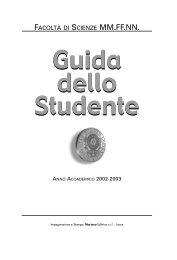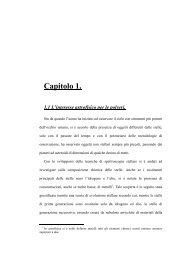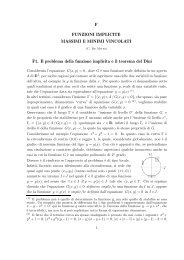Curriculum Vitae - Dipartimento di Fisica
Curriculum Vitae - Dipartimento di Fisica
Curriculum Vitae - Dipartimento di Fisica
Create successful ePaper yourself
Turn your PDF publications into a flip-book with our unique Google optimized e-Paper software.
• General Relativistic effects around peculiar objects as naked singularities<br />
and usual Schwarzschild and Kerr black holes<br />
• P.I. of an XMM Newton telescope observation toward the MACHO<br />
microlensing can<strong>di</strong>date MACHO BLG-95. This peculiar microlensing<br />
can<strong>di</strong>date event has been characterized by a long enough duration<br />
which allowed to use parallax methods in order to get information<br />
about the lens <strong>di</strong>stance. Hence, an estimate of the lens mass has been<br />
obtained. In particular, MACHO BLG-95 seems to be an object with<br />
mass 3-10 solar masses at a <strong>di</strong>stance 2-6 kpc from Earth. The unusual<br />
huge mass of the lens opens the possibility that MACHO BLG-95 is<br />
an isolated neutron star or a stellar mass black hole. In both cases,<br />
we expect that the object accretes the surroun<strong>di</strong>ng interstellar matter<br />
(for example via Bon<strong>di</strong> accretion mechanism) and emits ra<strong>di</strong>ation in<br />
the X-ray band. The expected X-ray is 10 −15 cgs, so that we have<br />
requested, and obtained, observing time (100 ks) with the XMM Newton<br />
telescope. Several X ray sources have been identified and are now<br />
under study. The data analysis performed on both the EPIC PN and<br />
EPIC MOS images allowed us to put an upper limit to the X-ray of<br />
10 −15 cgs coming from the source so that strong constraints on the<br />
Black Hole accretion mechanism can be put.<br />
At present, I’m studying the physics of obscured AGNs from the observational<br />
(XMM-RGS data) point of view and de<strong>di</strong>cate part of my<br />
time in analyzing XMM data of seren<strong>di</strong>pitous sources. In particular,<br />
I’m interesting in Low-mass X-ray binaries, i.e. peculiar binary systems<br />
composed of a compact object and a low-mass star. Recently, a<br />
new class of these systems, known as symbiotic X-ray binaries (with<br />
a neutron star with a M-type giant companion), has been <strong>di</strong>scovered.<br />
Up to now, only a few objects (three or four) of this kind are known.<br />
We have possibly <strong>di</strong>scovered one of the best can<strong>di</strong>date. Other interests<br />
in the use of XMM data are in the study of interme<strong>di</strong>ate-mass black<br />
holes (IMBHs) and cataclysmic variables (CVs).<br />
Cosmology<br />
• I was involved in the VST (Very Large Telescope Survey Telescope)<br />
project which will undergo a survey of the sky up to the magnitude 24.<br />
For the collaboration, I developed programs (C and IDL) to simulate<br />
deep field images useful for the pipeline analysis. The code is still<br />
under development.<br />
Membership<br />
• INFN associate (Istituto Nazionale <strong>di</strong> <strong>Fisica</strong> Nucleare).








